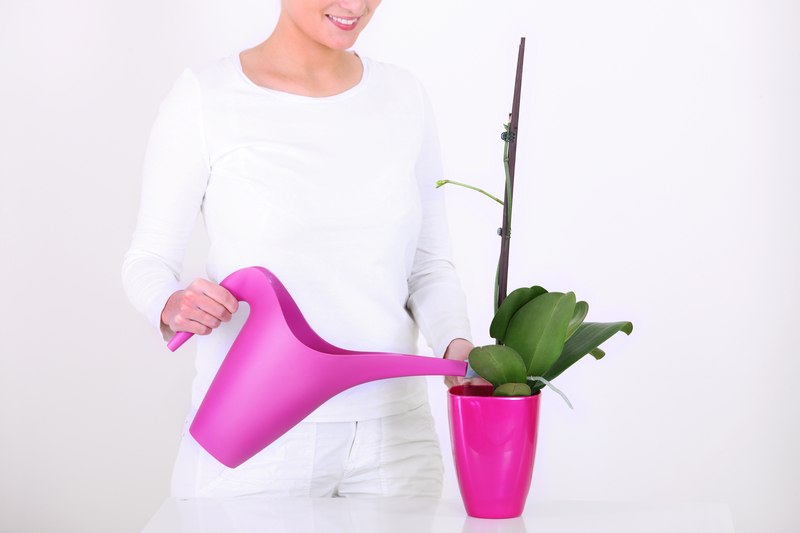Unlock the Potential of Vertical Gardening
Posted on 02/06/2025
Unlock the Potential of Vertical Gardening: A Comprehensive Guide
Vertical gardening is rapidly gaining popularity among urban dwellers, home gardeners, and landscape designers. This innovative approach to growing plants makes efficient use of limited space and opens up new possibilities for city balconies, patios, fences, and even the walls of your home. In this article, we will unlock the potential of vertical gardening, explore its many benefits, and provide actionable tips to help you start your own lush, upward-growing garden.

What Is Vertical Gardening?
Vertical gardening is the practice of growing plants on a vertically suspended panel or structure using soil, hydroponic, or aeroponic growing methods. Instead of spreading out horizontally in traditional beds or pots, plants grow upwards, maximizing the use of vertical space. This gardening style can range from simple DIY wall-mounted planters to elaborate "living walls" covering entire building exteriors.
Different Types of Vertical Gardens
- Pocket Planters: Fabric, felt, or plastic pouches that hang on walls and hold individual plants.
- Trellises & Lattices: Structures that support climbing plants like beans, peas, or flowering vines.
- Pallet Gardens: Upcycled shipping pallets filled with growing medium and arranged vertically.
- Stacked Planters: Tiered containers that increase elevation and support various plant species.
- Living Walls: Professional systems that cover large areas with interconnected modules for holding plants and soils.
The Many Advantages of Vertical Gardening
There are numerous advantages to embracing vertical gardening techniques, making them suitable for a wide variety of gardening enthusiasts:
- Space-saving: Perfect for apartments, balconies, courtyards, and small urban spaces where ground area is limited.
- Enhanced aesthetics: Vertical gardens transform dull walls and fences into beautiful, living artwork.
- Air purification: Plants filter out pollutants, improving indoor and outdoor air quality.
- Greater yields: Maximize harvest per square foot by growing up, not out.
- Pest and disease control: Improved airflow and reduced contact with soil can lower the risk of pests and diseases.
- Reduced weed growth: Less exposed soil means fewer weeds take root, saving time and effort.
- Better accessibility: Vertical gardens are often easier to maintain, especially for people with physical limitations.
How Vertical Gardening Benefits Urban Living
With global urbanization on the rise, more people are turning to vertical gardening solutions to connect with nature amidst concrete and steel. Vertical gardens introduce greenery into cityscapes, helping to offset the "urban heat island" effect. These living walls and green facades act as insulation, regulating temperatures and potentially lowering energy bills.
By utilizing multiple heights and surfaces, apartment dwellers or urban homeowners can enjoy fresh herbs, vegetables, and flowers even where ground-level gardens aren't feasible. Unlocking the potential of vertical gardening can truly transform urban environments, making them healthier, more beautiful places to live.
What Plants Are Best for Vertical Gardens?
Almost any plant can be adapted for vertical garden structures, but certain species thrive particularly well in an upright format. The best choices depend on your light availability, climate, and aesthetic goals. Here are some excellent candidates:
Herbs:
- Basil
- Mint
- Parsley
- Cilantro
- Thyme
- Oregano
Leafy Greens and Vegetables:
- Lettuce
- Spinach
- Kale
- Swiss chard
- Strawberries
- Cherry tomatoes (in sturdy systems)
- Peppers
Ornamental Plants and Flowers:
- Pothos
- Philodendron
- Spider plant
- Petunia
- Ferns
- Begonias
- Impatiens
Important Factors for Plant Selection
- Light requirements: Make sure your plant choices suit the sun or shade conditions of your space.
- Root depth: Opt for plants with shallow or compact root systems for wall-mounted or smaller pocket planters.
- Water needs: Group plants with similar watering requirements to simplify care and promote health.
- Growth habit: Trailing, vining, or compact bushy plants tend to work best in vertical arrangements.
How to Start Your Own Vertical Garden
Ready to unlock the potential of vertical gardening at home? Follow these key steps:
1. Choose the Right Location
Identify a spot that gets enough sunlight for your chosen plants, such as a balcony, patio wall, fence, or even an indoor room with bright natural light. Consider accessibility for watering and maintenance.
2. Select Your Vertical Structure
Options include off-the-shelf vertical planters, DIY pallet gardens, trellises, or living wall kits. For indoors, fabric pocket panels or modular shelving systems work well. Outdoor spaces may accommodate custom-built racks or wall-mounted containers.
3. Prepare the Structure
- Ensure the vertical garden frame is sturdy and securely anchored.
- Install a waterproof barrier (especially indoors) to protect walls from water damage.
- Set up an accessible watering system, such as hand watering, drip irrigation, or self-watering planters.
4. Select and Arrange Your Plants
Plan your plant layout based on height, color, growth habit, and growing requirements. Place sun-loving plants at the top (where light is strongest) and shade-tolerant varieties near the bottom. Combine herbs, veggies, flowers, and foliage for a rich, textured look.
5. Use Appropriate Growing Medium
Regular garden soil is usually too heavy for vertical gardens. Use a lightweight, nutrient-rich potting mix, or specialized soilless blends designed for wall gardens. Ensure good drainage to prevent root rot.
6. Water and Feed Consistently
- Vertical gardens dry out more quickly than traditional gardens - check soil moisture frequently.
- Water from the top and allow it to trickle downward, or use drip irrigation systems.
- Feed with liquid or slow-release fertilizers to ensure plants receive necessary nutrients.
Creative Ideas to Unlock the Potential of Your Vertical Garden
Vertical gardening offers endless opportunities for personal expression and innovation. Here are some creative approaches to maximize your vertical gardening potential:
- Living art walls: Design intricate patterns with colorful foliage and flowering plants for a stunning visual effect.
- Edible vertical gardens: Combine compact fruits, vegetables, and herbs for a productive urban farm.
- Privacy screens: Install trellises with climbing vines to create green barriers on balconies or patios.
- Pallet or container gardens: Repurpose shipping pallets or stackable pots in creative arrangements for a rustic or modern look.
- Seasonal plant swaps: Rotate annuals and perennials, or update sections for changing seasons and color schemes.
Challenges and Solutions for Vertical Gardening
While vertical gardens unlock exciting opportunities, they come with unique challenges. Anticipating and addressing these will help you succeed:
- Watering: Vertical setups dry out faster. Use self-watering mechanisms or drip lines, and group plants by water needs.
- Weight: Soil, water, and mature plants add weight. Ensure your wall or structure is strong and properly supported.
- Sunlight: Lower sections may get less light. Choose shade-tolerant varieties or install reflective surfaces/lights.
- Maintenance: Vertical layouts may need more frequent pruning for air flow and shape; mulch to retain moisture and suppress weeds.
- Pests & disease: Monitor closely for pests, as closely spaced plants can spread issues quickly. Rotate crops and clean planters regularly.

Vertical Gardening for Sustainability
Unlocking the potential of vertical gardening isn't just about beauty and food; it's a significant step toward sustainable urban living. Vertical gardens:
- Improve air quality by absorbing CO2 and releasing oxygen.
- Mitigate noise pollution and insulate buildings.
- Promote biodiversity by providing habitats for birds, insects, and beneficial pollinators.
- Contribute to food security and reduce food miles by letting you grow your own produce locally.
- Help manage stormwater runoff by absorbing rainwater.
How to Make Vertical Gardening Part of a Greener Lifestyle
- Choose native or drought-resistant plants to reduce water consumption.
- Use organic fertilizers and natural pest control methods.
- Compost plant waste and use recycled materials for garden structures.
- Encourage neighbors and businesses to consider green walls and shared vertical gardens.
Conclusion: Unlocking the Future of Urban Gardening
Vertical gardening provides an elegant solution to the constraints of modern living--limited space, pollution, and the desire for fresh, homegrown produce. By unlocking the potential of vertical gardening, you harness green innovation for your home, neighborhood, and environment.
Whether you're a beginner with a small patio or an experienced gardener seeking new challenges, exploring upward-growing gardens offers limitless creativity and practical rewards. Start with a simple hanging herb wall or scale up to a lush, multi-tiered installation--either way, you'll soon appreciate the transformation vertical gardening brings to both your space and your lifestyle.
Let your imagination soar skyward--and turn your walls, balconies, and fences into a thriving, sustainable tapestry of life. Unlock the transformative potential of vertical gardening today!



